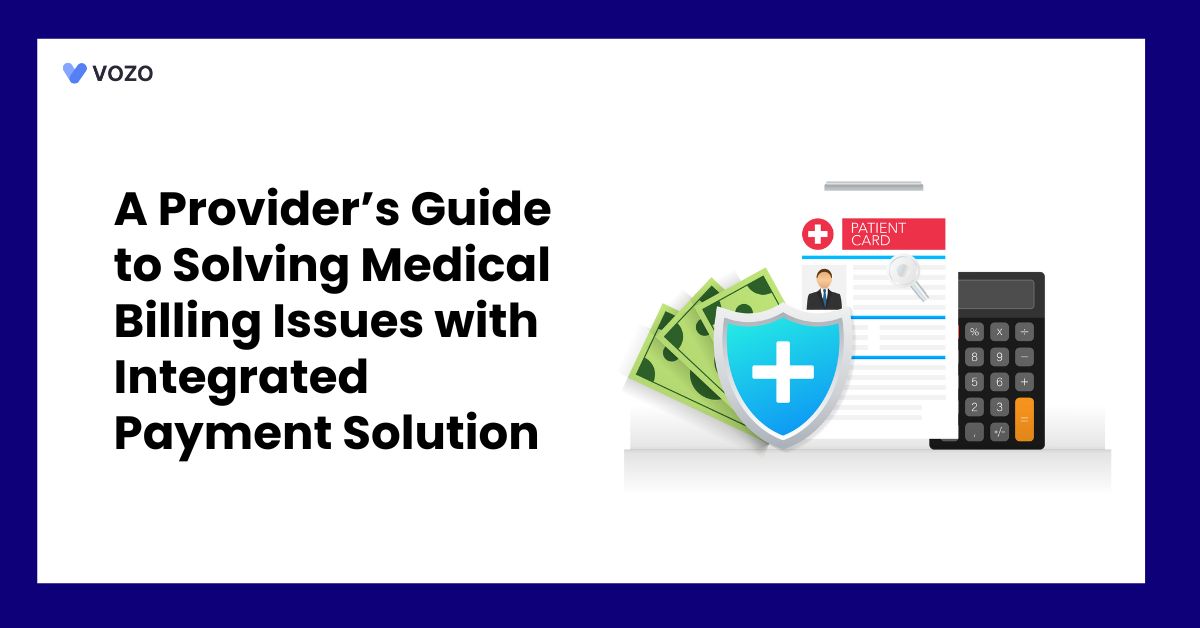A Provider’s Guide to Solving Medical Billing Issues with Integrated Payment Solution
Across all healthcare, including hospitals, clinics, specialty practices, and others, providers used to face one big struggle – Payment delays. This has become a huge challenge and concerning healthcare providers all over the U.S. Complex medical billing administration systems contribute to declining margins and cash flow concerns for many practices.
However, these challenges can be effectively solved with the right solutions. Implementing these solutions can help healthcare providers to overcome or recover from the administrative difficulties. All while improving revenue cycle management.
In this blog post, we have shared the common challenges associated with medical billing and how an integrated payment solution can solve many billing challenges and improve the RCM process.
Common Medical Billing Challenges Faced by Providers
Medical Billing operations are associated with many challenges in general. Over 80% of medical bills contain errors. This creates frustration for both patients and providers as well. Here are some of the common medical billing challenges often faced by healthcare providers.
1. Patient Education Gaps & Non-Modernized Billing Methods
A Patient Engagement HIT survey shows that less than half of healthcare consumers comprehend their medical costs. Half of the individuals who answered the study reported that they had recently paid medical expenses and were confused about them.
According to the report, consumers expressed dissatisfaction with patient billing and payment processes. Nearly one-third say that healthcare practitioners can do more to improve these procedures, such as adopting better technology.
For example, 49% of survey respondents expressed frustration with their provider’s failure to implement digital administrative operations such as online bill pay, access to insurance information.
Participants also report that their providers are still sending them healthcare invoices via traditional mail. Why does this matter for healthcare providers?
This highlights the critical need for implementing advanced medical billing software and online payment options. Without adopting these technologies, their healthcare practices might struggle financially. This especially goes to small healthcare practices. Also, the healthcare providers need to stay updated with the current and effective billing methods.
2. Unexpected Medical Costs & Lack of Transparency
According to a study, unexpected medical costs are one of the major reasons healthcare consumers are delaying medical bill payments.
Approximately 60% attempted to obtain out-of-pocket charges from providers before care, but 51% claimed that they could have acquired information more swiftly and precisely. The main cause here is that the healthcare industry often lacks transparency in medical costs. This leaves a shock for healthcare consumers regarding unexpected costs.
So, how can healthcare providers address these challenges? Here are some of the proven strategies:
- Healthcare providers need to explain to patients beforehand about what payers will and will not pay for the service.
- Increase pricing transparency and implement online medical bill payment options to make it convenient for patients to pay anytime.
- Create a more concise billing statement with only relevant information.
- Provide better payment support for frequently asked billing inquiries.
- Implement various online payment options and methods like Google Pay, Credit/Debit card, and others.
3. Medical Billing Workflow Issues
The medical billing workflow is the most complex operation. These issues can lead to delays, claim denials, and financial losses for medical practices.
According to a report, most individuals say that one out of ten claims is getting denied. Here are some of the common medical billing workflow issue that often leads to claim denials:
- Missing details like name, date of birth, or insurance ID can cause claim rejections.
- Incorrect or outdated medical codes (CPT, ICD-10) can result in claim denials or underpayments.
- If claims aren’t submitted on time, insurance companies may reject them, causing revenue loss.
- Failing to check a patient’s insurance coverage before treatment can lead to denied claims.
- If denied claims aren’t corrected and resubmitted quickly, practices miss out on payments.
Poor workflow issues also result in a poor patient experience, leaving a negative impression even after they depart. In reality, one in three healthcare consumers is dissatisfied with their provider’s medical billing procedure.
These medical billing workflow issues can be resolved by using automated billing systems, staff training, and regular audits to ensure accuracy.
4. Payment & Processing Delays
In medical billing, coding for procedures is the most complex aspect. This often leads to waiting weeks or even months to see payments for providers. Practices usually wait for up to 60+ days after scheduling appointments for the payment for services rendered.
EHR systems play a major role and have become the common place for healthcare providers and payers to share information electronically. But still manual workflow highly influences the medical workflow.
This is where automation steps in. Automation might save almost an hour of staff time for every three claim status checks. To ensure efficiency, medical billing and coding should be as automated as feasible. If not, payment and processing delays could occur.
Related: Are You Making These Common Medical Billing Mistakes? Fix Them In 2025
How Integrated Payment Solutions Improve Medical Billing
Advanced integrated payment solutions can completely transform the medical billing workflow. According to a study, over 80% of healthcare consumers use smartphones, but still, providers are sending paper-based bills.
Related: The Definitive Guide to Medical Billing
With solutions like Integrated payment options in EHR and patient portal, providers interact with patients by engaging them where they are – online and on their mobile devices. Here is how an integrated payment solution solves major medical billing challenges.
1. Streamlining Payment Workflows
EHR Integrated with a payment solution can automate the patient statement process and payment acceptance through online payment models. This will help to simplify and streamline the payment workflow with minimal interference of providers.
2. Simplifying Record-Keeping
The system will automatically generate an invoice based on the services and send it to patients through the portal platforms with just a single click. And then the providers will receive payments in one seamless transaction.
3. Accepting Payments Anytime, Anywhere
EHR-integrated payment solutions allow providers to accept payments anytime, anywhere.
4. Enhancing Revenue Cycle Management
As said earlier, practices often used to wait around 60+ days to receive payments after scheduling an appointment. With the help of EHR EHR-integrated payment solution, providers can get paid over 96% of claims within 60 days.
Vozo Cloud EHR Integrated with Medical Billing
Medical billing is a complex healthcare operation that requires efficiency and precision. Delayed payments, claim denials, and manual errors can slow your revenue cycle and affect cash flow.
With Vozo’s Cloud EHR solution, you get an integrated medical billing system that simplifies your billing process and enhances real-time claim tracking to improve payment turnaround.
How Vozo EHR Transforms Medical Billing:
- Streamline billing workflows and reduce administrative workload.
- Instantly identifies and corrects coding errors before claim submission.
- Speeds up claim verification with automated payer communication.
- Ensures compliance with built-in coding checks and regulatory updates.
- Offers real-time analytics and reporting for better decision-making.
- Minimizes delays by automating claims processing and payments.
- Reduces billing disputes with accurate, transparent invoicing.
Vozo EHR’s seamless integration with medical billing empowers healthcare providers to reduce errors, prevent delays, and optimize revenue cycles, while focusing on delivering better patient care.
About the author

With more than 4 years of experience in the dynamic healthcare technology landscape, Sid specializes in crafting compelling content on topics including EHR/EMR, patient portals, healthcare automation, remote patient monitoring, and health information exchange. His expertise lies in translating cutting-edge innovations and intricate topics into engaging narratives that resonate with diverse audiences.













